Other Parts Discussed in Thread: TMUX1574
Hi Sir,
My customer has used the SN74CBT3257C on the SPI mux application and found the cross-talk issue for the clock signal.
They also try to use the TMUX1574, still can not fix this issue.
You can see the below cross-talk waveform(SPI CLK at 40MHz), they removed the R59 and monitor the pin-5 of the SN74CBT3257C.
May I know how to fix this issue?




